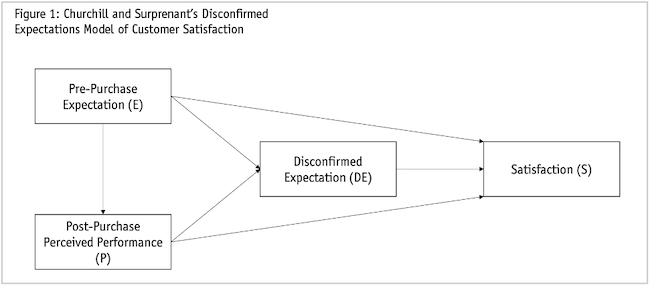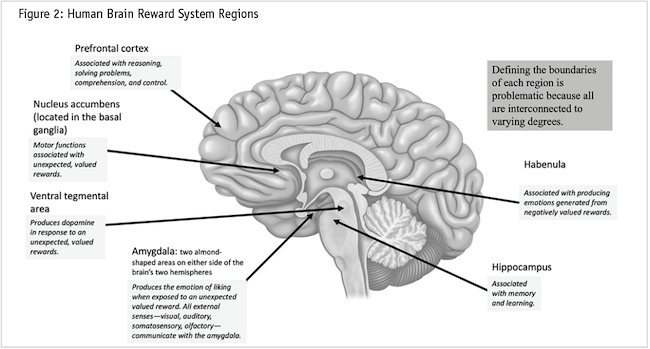Hardwired for satisfaction
Editor's note: Terry Grapentine is an independent marketing research consultant. He can be reached at tgrapentine@gmail.com. He wishes to thank David Soorholtz, principal of VetSense, and R. Kenneth Teas, emeritus professor of business, Iowa State University, for reviewing this article and making helpful suggestions.
The customer expectations concept has been in the marketing lexicon for many decades. In 1982, Gilbert Churchill, Jr., and Carol Surprenant formalized the definition of this concept1 as it relates to predicting customer satisfaction. They conceptualized “expectations” as a forecast of perceived product performance to discover if a product exceeds, meets or underperforms the customer’s expectation.
This article encloses the term “expectations” in quotes when referring to it as a concept. When this term describes a customer’s belief, no quotes appear, e.g., the customer’s expectation was that a cookie would have between five and seven chocolate chips, no more, no less.
In the 1990s, the field of neuroscience began to investigate the biological basis for the “expectations” concept. Neuroscience has shown how the brain continuously 1) forecasts our internal, homeostatic body-state (e.g., body temperature, blood pressure) and 2) alters our physiological and behavioral responses to external, allostatic stimuli (e.g., threats, opportunities). The brain does this to detect unexpected changes affecting our survival and well-being. Translating this to consumer purchasing behavior, customer “expectations” relates to the unexpected difference between forecasted product performance and post-purchase perceived product performance. Did the product perform as expected?
There is, therefore, a proven neurological basis for the “expectations” concept in marketing. This article relates how neuroscientists demonstrated this relationship and how marketers can leverage it to their advantage.

Figure 1 shows how Churchill and Surprenant incorporated several expectations concepts as predictors of customer satisfaction. Here’s an interpretation, based on an example of purchasing a kitchen refrigerator:
Pre-purchase expectation (E): Forecasted product performance, e.g., “When I go shopping for a new fridge, I forecast that all refrigerator manufacturers offer only a 10-year warranty.”
Post-purchase perceived performance (P): Actual product performance, e.g., “Great! I got a 15-year warranty on my fridge vs. the 10 years I thought I would get.”
Disconfirmed expectation (DE): Is given by the formula, (P – E).
In our example, (P – E) = (15 years – 10 years) = +5 years.
In this example, receiving five more years of warranty results in an increase in satisfaction; satisfaction was disconfirmed positively. Disconfirmed means that P ≠ E.
However, in some situations, P – E < 0 represents an increase in satisfaction. For instance, one expects to wait in a bank-teller line for five minutes but only waits two minutes. Now (P – E) = (two minutes – five minutes) = -three minutes. Customers prefer shorter to longer lines, therefore, a negative (P – E) denotes an increase in satisfaction.
The arrows denote the functional relationships among the concepts. In applied research, tools such as structural equation modeling estimate coefficients reflecting how much one concept influences another, either directly or indirectly.
Satisfaction (S): Satisfaction either increases, decreases or does not change for a given attribute based on the model’s coefficients. The authors used a multi-item scale to measure the satisfaction concept. For example, one measure they used was a seven-point scale ranging from “I like this [product]” to “I dislike this [product].”2
Neurological foundation of customer expectations

So, what happens in your brain when expectations do not match reality? A lot.
Our story begins with Wolfram Schultz et al., who recorded responses from neurons in the midbrains of monkeys.3 This area of the brain is known as the brain’s reward system4 or the reward pathway.5
Schultz’s research called for placing small electrodes in the ventral tegmental area (VTA) of a monkey’s brain, which is comparable to its location in the human brain. When a monkey (or human) is at rest, the VTA’s neurons fire at a frequency called its base rate of firing. “Schultz noticed that the neuron’s base rate of firing shot up (that is, spiked) if the monkey unexpectedly received a valued reward (a squirt of juice).”6 Another term for “spiked” is prediction error: “the discrepancy between the expected outcome (the VTA’s base rate) of an action and the outcome that actually occurred [the VTA’s spike].”7
Similar studies on humans using different tools, e.g., alternative brain scanning methods, show that the brain’s reward system in monkeys and humans is similar. In fact, “the [brain’s] cortex has essentially the same architecture in all mammals, whether bats or baboons or us.”8
Unexpected, valued rewards cause a prediction error in the VTA’s base rate.9 When excited in this way, the VTA releases the neurotransmitter dopamine, which communicates information to other parts of the brain, nearly simultaneously.10 The more exciting the subject finds the stimulus, which is learned over life’s experiences, the more dopamine the VTA produces.
Amygdala: influences emotion creation (“I really like that 15-year warranty on the fridge!”).
Nucleus accumbens: controls the body’s motor functions (“I’m going to walk over to that fridge and look at it more closely.”).
Prefrontal cortex: relates to planning, decision-making (“All things considered, I am going to buy that fridge.”).
Hippocampus: memory formation (“I need to remember this brand next time I want to buy an appliance.”).
When a stimulus activates the brain’s reward system – and this activation occurs subconsciously11 – your brain tells you something unexpectedly good happened, it delivers positive reinforcement, “This is good, let’s do it again!”12 This is what produces the various emotional levels of pleasure you feel. And your brain does this whenever, out of the blue, you receive a compliment, win at a game, eat delicious food or get something you value from a product you did not expect.13 (The process is more complicated than explained here. See footnotes for additional sources and more elaborate discussions of the reward system.)
As Churchland says, “What these neurons in the VTA care about is the difference between what was expected at a certain time and what actually occurred at that time…”.14 This is what Churchill and Surprenant call “disconfirmed expectations.” An analogous sequence of events occurs whenever, unexpectedly, you experience an event you dislike, causing different parts of the brain to produce different neurotransmitters (e.g., the habenula releases serotonin).
Leverage this knowledge
Science has validated the existence and meaning of customer “expectations.” Consequently, the concept has a solid foundation in marketing and neurobiology. So, how do marketers leverage this knowledge?
Conduct research with customers and brainstorm with marketing executives to come up with a customer-expectations strategy. There are numerous sources of information you can search on the internet. For instance, a Google query of “how companies exceed customer expectations” identified over 380 million citations!
Keep in mind that you must define what “expectations” means in the context of your products and target market segments. It is not a simple one-size-fits-all definition. Consumers’ expectations must be studied via primary research. For example, in a study commissioned by a worldwide cruise line company, the research department added the following questions to their customer-experience tracking study:
On your last cruise with …, did anything happen that surprised you in a positive way?
□ Yes (ASK OPEN-ENDED QUESTION)
□ No
Please explain:
On your last cruise with…, did anything surprise you in a negative way?
□ Yes (ASK OPEN-ENDED QUESTION)
□ No
Please explain:
Research findings delivered insights into the nature of these surprises that most influenced brand loyalty and helped management brainstorm future strategies and tactics.
Finally, a product cannot exceed a customer’s expectations endlessly – the brain imposes guardrails on its reward system.15 Schultz’s experiments show that successive squirts of juice in the monkey’s mouth sequentially reduce the spikes in VTA-neuron activity, dopamine production and the feeling of pleasure. This is also true for consumers. For a company to advertise, “We exceed our customers’ expectations,” implying they do this all the time, is a fool’s errand. Therefore, introduce variety over time in your customer-expectation strategies and tactics. After all, variety is the spice of life and a key to attracting and keeping customers.
References
1 Churchill, Jr., Gilbert A., and Carol Surprenant (1982), “An investigation into the determinants of customer satisfaction,” Journal of Marketing Research, November, pp. 491-492. Available on Google Scholar
2 Grapentine, Terry, (2019), “Why customer satisfaction is hard to define,” Quirk’s Marketing Research Review, October, pp. 36-40, available at: www.quirks.com/articles/2019/20191008.aspx
3 Churchland, P.S., (2019), p. 75.
4 Churchland, P.S., (2019), figure 3.1, p. 72.
5 Khan Academy (2023), “Reward pathway in the brain,” retrieved from: https://www.youtube.com/watch?v=YzCYuKX6zp8
6 Churchland, P.S., p. 75.
7 Eagleman, David and Jonathan Downar, (2015), Chapter 4, “How Do I Decide”? p. 448.
8 Churchland, P.S., (2019), p. 30.
9 Different authors describe the reward pathway differently. This interpretation is based on material from the Kahn Academy (2023) and Churchland, P.S., (2019), pp. 75-85.
10 Additional neurotransmitters are involved such as endogenous opioids, analogous to opium, and cannabinoids, analogous to cannabis.
11 Eagleman, David and Jonathan Downar, (2015), Chapter 4, “How Do I Decide”? pp. 108-144.
12 Kahn Academy, (2023), time stamp, 3:04.
13 P.R. Montague, P. Dayan, and T.J. Sejnowski, (1996), “A framework for mesencephalic dopamine systems based on predictive Hebbian learning,” Journal of Neuroscience, 16, no. 5, pp. 1936-47.
14 Churchland, P.S., (2019), p. 79.
15 Drugs such as heroin and morphine can obliterate these guardrails. See Eagleman and Downar (2015), Chapter 14, “Addiction: Pathological Learning and Motivation,” pp-457-469.